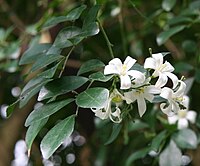
Murraya paniculata (L.) (Orange Jasmine): Potential Nutraceuticals with Ameliorative Effect in Alloxan‐Induced Diabetic Rats
Sign Up to like & getrecommendations! Published in 2017 at "Phytotherapy Research"
DOI: 10.1002/ptr.5903
Abstract: Orange jasmine, Murraya paniculata (Rutaceae), is a plant from India widely used in folk medicine as antinociceptive, antiinflammatory, and antioxidant. Although oral hypoglycemic agents and insulin are the mainstays of treatment of diabetes mellitus (DM),… read more here.
Keywords: murraya paniculata; induced diabetic; alloxan induced; orange jasmine ... See more keywords

Bioactivity of Murraya paniculata Against Almond Moth Cadra cautella and Leaf-Eating Caterpillar Spodoptera litura
Sign Up to like & getrecommendations! Published in 2021 at "National Academy Science Letters"
DOI: 10.1007/s40009-021-01083-6
Abstract: Botanical insecticides are known to affect insects through various mode of action which includes toxicity through ingestion, contact, antifeedant, growth inhibition, repellency, etc. The present study was aimed to explore the potential of Murraya paniculata… read more here.
Keywords: murraya paniculata; moth cadra; litura; almond moth ... See more keywords

Seasonal and diel variations in scent composition of ephemeral Murraya paniculata (Linn.) Jack flowers are contributed by separate volatile components
Sign Up to like & getrecommendations! Published in 2020 at "Biochemical Systematics and Ecology"
DOI: 10.1016/j.bse.2020.104004
Abstract: Abstract Scent profile of the ephemeral nocturnal floral species Murraya paniculata was characterized to assess diel and seasonal variability. The floral fragrance was found to constitute a characteristic set of 15 major volatile organic compounds… read more here.
Keywords: methyl; variations scent; contributed separate; murraya paniculata ... See more keywords

Polymethoxylated flavonoids from Murraya paniculata (L.) Jack
Sign Up to like & getrecommendations! Published in 2020 at "Biochemical Systematics and Ecology"
DOI: 10.1016/j.bse.2020.104162
Abstract: Abstract A new flavone, 3′-hydroxy-5,6,7,4′,5′-pentamethoxyflavone (1), and three natural products (7, 10, and 14) were isolated from the leaves and twigs of Murraya paniculata (L.) Jack, together with 10 reported polymethoxylated flavonoids. The structure of… read more here.
Keywords: murraya paniculata; paniculata jack; ecology; flavonoids murraya ... See more keywords

Presence and abundance of Diaphorina citri in Murraya paniculata in urban areas free of huanglongbing in Brazil
Sign Up to like & getrecommendations! Published in 2020 at "Entomologia Experimentalis et Applicata"
DOI: 10.1111/eea.12968
Abstract: Asian citrus psyllid (ACP), Diaphorina citri Kuwayama (Hemiptera: Liviidae), is the vector of the bacterium Candidatus Liberibacter sp., a quarantine pathogen in citrus production areas such as Australia, Europe, and northeast Brazil, associated with huanglongbing… read more here.
Keywords: urban areas; presence; murraya paniculata; abundance ... See more keywords

Antimicrobial, antioxidant, and angiogenic bioactive silver nanoparticles produced using Murraya paniculata (L.) jack leaves
Sign Up to like & getrecommendations! Published in 2022 at "Nanomaterials and Nanotechnology"
DOI: 10.1177/18479804211056167
Abstract: Murraya paniculata (MP) can be used as a reducing agent to produce silver nanoparticles (AgNPs) using a simple procedure. AgNPs are characterized in morphological and chemical properties, antioxidant activity, and cytotoxicity. The morphology of AgNPs… read more here.
Keywords: stretch; murraya paniculata; silver nanoparticles; activity ... See more keywords

Molecular differentiation of the Murraya paniculata Complex (Rutaceae: Aurantioideae: Aurantieae)
Sign Up to like & getrecommendations! Published in 2019 at "BMC Evolutionary Biology"
DOI: 10.1186/s12862-019-1555-4
Abstract: BackgroundOrange jasmine has a complex nomenclatural history and is now known as Murraya paniculata (L.) Jack. Our interest in this common ornamental stemmed from the need to resolve its identity and the identities of closely… read more here.
Keywords: murraya paniculata; molecular differentiation; differentiation murraya; paniculata complex ... See more keywords

IDENTIFICACIÓN Y EVALUACIÓN DE LA INCIDENCIA DE INSECTOS Y HONGOS BENÉFICOS ASOCIADOS A Diaphorina citri KUWAYAMA (HEMIPTERA: LIVIIDAE) EN PLANTAS TRASPATIO (Citrus spp. y Murraya paniculata) DEL CANTÓN CATAMAYO (LOJA - ECUADOR)
Sign Up to like & getrecommendations! Published in 2020 at "Revista 180"
DOI: 10.36331/revista.v7i1.99
Abstract: In recent years the global citrus industry has been threatened by the presence of the Asian citrus psyllid Diaphorina citri, a harmful insect carrying the Candidatus Liberibacter bacterium that which causes the Huanglongbing disease (HLB),… read more here.
Keywords: catamayo; murraya paniculata; diaphorina citri; citrus ... See more keywords

In vivo Efficacy of Murraya paniculata Leaf in Controlling Natural Helminthiasis in Goat
Sign Up to like & getrecommendations! Published in 2019 at "American Journal of Animal and Veterinary Sciences"
DOI: 10.3844/ajavsp.2019.95.100
Abstract: This study investigated the in vivo effect of Murraya paniculata leaf on gastrointestinal nematodes reduction, growth rates and haematological changes of goats. Four experimental groups (n = 6) of goats naturally acquired gastrointestinal nematodes were… read more here.
Keywords: goat; paniculata leaf; paniculata; murraya paniculata ... See more keywords

Two flavonoid-based compounds from Murraya paniculata as novel human carbonic anhydrase isozyme II inhibitors detected by a resazurin yeast-based assay.
Sign Up to like & getrecommendations! Published in 2019 at "Journal of microbiology and biotechnology"
DOI: 10.4014/jmb.1910.10037
Abstract: Human carbonic anhydrase isozyme II has been used as protein target for disorder treatment including glaucoma. Current clinically used sulfonamide-based CA inhibitors can induce side effects, and so alternatives are required. This study aimed to… read more here.
Keywords: carbonic anhydrase; human carbonic; murraya paniculata; yeast based ... See more keywords